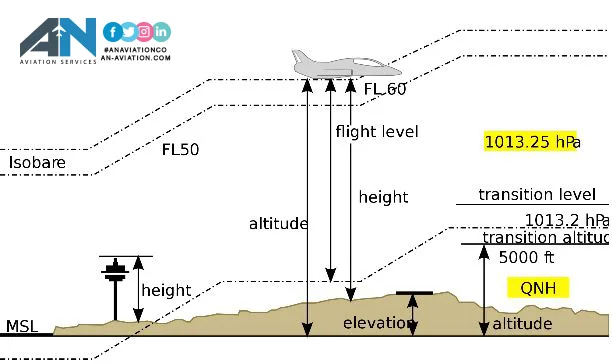
When it comes to flying, knowing an aircraft’s elevation is crucial for safety and navigation. But what does “elevation” mean in aviation, and why are there so many types of altitudes? From flight levels to pressure altitude, pilots and air traffic controllers rely on specific measurements to ensure safe distances between planes and the ground.
In this post, we’ll explore the different types of aircraft elevation, explain their importance, and see why pilots constantly adjust their altimeter setting throughout the flight. Let’s dive into the basics of altitude and how it helps flights stay on course.
True Altitude: The Actual Height Above Sea Level
True Altitude is the real vertical distance between an aircraft and mean sea level. When we talk about how high a plane is flying in everyday language, we’re often referring to its True Altitude. This measurement indicates the airplane’s elevation above the surface of the ocean, regardless of the terrain below.
How It’s Measured: True Altitude is calculated using the altimeter setting combined with information about local terrain. Modern systems also rely on GPS and terrain databases to ensure accuracy.
Importance: Knowing True Altitude is essential for flights passing over mountains or rough terrain. It’s also the measurement shown on in-flight displays for passengers.
For travelers, True Altitude gives a clearer understanding of just how high above sea level the plane is flying, ensuring a safe clearance over hills, mountains, and other obstacles.
Indicated Altitude: The Reading on the Altimeter
Indicated Altitude is the altitude shown on the aircraft’s altimeter when the pilot inputs the local atmospheric pressure. This value depends on the current weather conditions at the aircraft’s location and changes as the plane moves through different regions.
How It’s Measured: Pilots adjust the altimeter based on information from air traffic controllers or local airports. This adjustment is necessary because atmospheric pressure changes with weather conditions and elevation.
Importance: Indicated Altitude helps pilots maintain safe distances from other aircraft and communicate with air traffic controllers. During takeoff and landing, the altimeter is set to the current local pressure to ensure accurate altitude readings close to the ground.
Pilots rely on Indicated Altitude as a reference during critical phases like takeoff, landing, and cruising at lower levels where terrain and obstacles pose a potential risk.
Pressure Altitude: The Standardized Altitude Reference
Pressure Altitude is the altitude above a standard atmospheric pressure level of 29.92 inches of mercury (inHg). This measurement is used to create a consistent reference point across all aircraft, regardless of local weather conditions. At higher altitudes, where weather variations are less pronounced, having a standard pressure setting simplifies navigation and communication.
How It’s Measured: Pilots set the altimeter to 29.92 inHg (the standard pressure) once they pass the transition altitude (usually 18,000 feet in the United States). From this point, all planes at higher levels refer to Pressure Altitude to maintain consistency.
Importance: Pressure Altitude is used to establish flight levels above the transition level. By having all planes use the same standard pressure setting at higher altitudes, air traffic controllers can easily manage and separate aircraft in the sky.
When flying at high cruising altitudes, Pressure Altitude ensures that every aircraft is operating on the same page, preventing misunderstandings and maintaining safe vertical separation.
Flight Levels: A Higher Altitude Measurement System
Once an aircraft crosses the transition level, altitudes are measured in flight levels instead of feet above sea level. A flight level (FL) is expressed as a multiple of 100 feet based on Pressure Altitude. For example, FL350 means the aircraft is cruising at 35,000 feet above the standard pressure level of 29.92 inHg.
How It’s Measured: Pilots adjust the altimeter to the standard setting of 29.92 inHg and refer to their elevation in flight levels.
Importance: Flight levels provide a common language for air traffic controllers and pilots, helping them maintain consistent altitudes and avoiding potential conflicts at higher altitudes.
For passengers, the change from standard altitude measurements to flight levels might go unnoticed, but it’s a crucial part of safe flight operations.
Factors That Influence Aircraft Elevation: Air Density and Temperature
Several factors can impact aircraft elevation, including air density and standard temperature. Changes in air density can affect the plane’s performance and the accuracy of altitude readings.
- Air Density: Lower air density at high altitudes can decrease engine performance and lift, requiring pilots to make adjustments.
- Standard Temperature: Temperature deviations from the standard temperature (15°C at sea level) can also impact altitude calculations, causing small errors in readings if not accounted for.
Pilots are trained to factor in changes in air density and temperature when planning their flights and making critical in-flight adjustments.
Conclusion: The Importance of Understanding Aircraft Elevation
Understanding the different types of aircraft elevation—from True Altitude to Pressure Altitude and Flight Levels—is essential for flight safety. Pilots, air traffic controllers, and onboard systems all work together to maintain safe distances between aircraft and terrain. By using standardized references like 29.92 inHg at high altitudes and adjusting for local atmospheric pressure, the aviation industry ensures smooth and efficient operations for all flights.
For passengers, knowing that these measurements are in place can provide peace of mind, as they represent the careful planning and coordination that keep aircraft safely separated in the skies.

